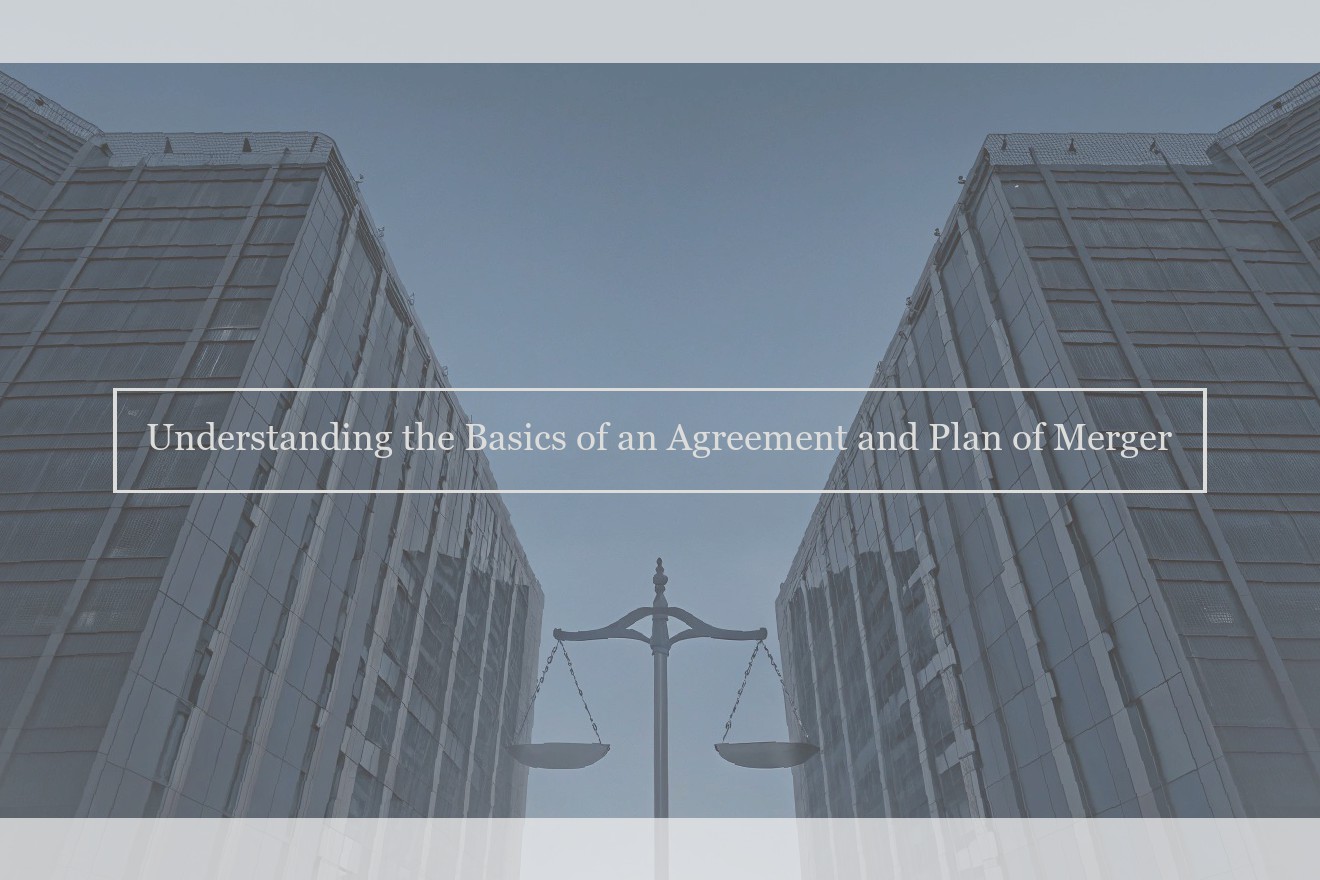Defining an Agreement and Plan of Merger
Merger is the combination of two corporations pursuant to law. The resulting entity is deemed to be the same business corporation as the one that was merged in with the surviving corporation. The surviving corporation continues in existence and has all of the real and personal property of each of the merging domestic corporations. The merger erases the rights of the merged corporation and creates a larger corporation under the law . Most commonly the merger is accomplished by the consolidation of the merging corporations’ boards of directors, and then the merger is authorized by a majority vote of the stockholders of each corporation in person or by proxy at a meeting or by written consent. The agreement and plan of merger is then approved by the secretary of state and becomes effective.

Elements of an Agreement and Plan of Merger
An agreement and plan of merger must detail many specific terms and conditions necessary for the completion of the business combination. The entities to be merged or consolidated must agree on the terms and conditions of the merger. This includes the manner of converting the securities of the merging entity into the securities of the surviving entity upon consummation of the transaction. Of course, other terms and conditions for the merger must include specific consideration in the form of cash, stock of the acquiring company or a combination thereof. Any representations and warranties of the merging entities to each other must be agreed. Defaults must be specified as well as how disagreements will be resolved. Also, the respective covenants of each entity to be merged need to be detailed. A complete understanding of the ultimate transaction is the end goal. The merger is complex and will often require some negotiation of the terms, conditions and structure. Only with a comprehensive understanding of the business combination, can the parties enter into it with a good chance of succeeding in the completion of a merger.
Legal and Regulatory Issues
The drafting and execution of an agreement and plan of merger will be subject to compliance with the legal and regulatory requirements. If the merger involves a publicly-held company, the exchange offer may require review and comment by the Securities and Exchange Commission. The antitrust aspects of a merger may require review by the government under the Clayton Act.
In addition, many states require notice to and sometimes approval by state agencies of the proposed transaction. States that require approval of a merger transaction sometimes have requirements that go beyond federal disclosure requirements. Also, approvals may be required from regulatory agencies that oversee the acquirer or the acquiree.
Upon completion of the merger, it is often necessary to obtain licenses and permits on the part of the surviving company.
Common Issues and Ways to Address Them
As with most aspects of the law, mergers and acquisitions are not foolproof processes. Even once you have structured an Agreement and Plan of Merger to your satisfaction, there are a few issues that may crop up during the actual merger.
Valuation difficulties: One of the most common challenges attorneys face during a M&A deal is valuation. It can be tricky to determine the appropriate value of the mergers and acquisitions, which can be further complicated by a number of factors (the parties’ size, future goals, share structure, whether it is public versus private, etc.). While some of these variables can make a purchase price difficult to determine, others do make for some generally more useful tools—like EBITDA, similar transaction multiples, discounted cash flow method, net assets and so on. Putting together all of this data and deciding which points should weigh more heavily in the overall calculation is often difficult, and requires an attorney to work closely with the merger parties to ensure the valuation makes sense in the context of their businesses.
Integration difficulties: It is crucial to implement a proper , seamless approach to integration—part of which is how the merger will be structured, but also entails weekends spent integrating IT departments, HR, accounting, etc. Poor planning in these processes can often lead to major headaches down the road. Of course, dealing with those department integrations is not why your clients hired you, but it is an important part of the process you must be involved in, either directly or indirectly. Another potential pitfall to keep in mind when it comes to integration is informing all employees—communicating changes efficiently and effectively builds trust and helps reduce potential issues.
Legal difficulties: Particularly in merger situations, a host of legal issues may arise, many of which are out of the control of you and your clients. Regulatory requirements like the Hart-Scott-Rodino Act and related premerger notification rules can cause delays and present obstacles. Guiding your clients through these issues and helping them address any bureaucratic problems that arise can help you build a strong relationship with your clients.
Examples of Successful Mergers
Examining best practices in agreement and plan of mergers is also a great way to learn from other companies and consider how the mergers are done. Here are a few examples: Wells Fargo/Wachovia Merger – In the 2008 merger of Wells Fargo with Wachovia, the terms of the merger included specific details about the operations of the two companies post-merger. For example, the agreement and plan explicitly stated that the combined company would retain its headquarters in San Francisco, and that the executive leadership team would be made up of a certain number of leaders from each company. This step was taken to reassure employees and investors that the larger entity would value both prior companies’ operations, and ensure that the combined company would maintain its focus on customer service and satisfaction. Lesson: Including detailed terms in the agreement and plan can mitigate uncertainty and address potential concerns or objections from shareholders. Berkshire Hathaway Precision Castparts Merger – Berkshire Hathaway, Inc.’s agreement to acquire Precision Castparts Corp. for approximately $32 billion in 2015 included a merger agreement with many pages of detailed terms and conditions. Some key sections included general provisions, expenses related to the transaction, and the handling of material adverse effect declarations. The agreement also had an appendix that provided details about additional terms and agreements, including representations, conditions, indemnification, and termination. The scope and detail of this agreement and plan covered a wide range of possible issues that could arise throughout the merger process, and such detail meant that investors and shareholders could have confidence in the process. Lesson: An agreement and plan that helps identify possible issues and accounts for the likelihood of certain future events can help establish investor and shareholder confidence. Dell Technologies/VMWare Merger – This merger was notable because it was a joint announcement between Dell Technologies, VMware, and Dell’s subsidiary, Silver Lake. This is an example of a merger that was done in the spotlight. The announcement of the merger was well-documented in the popular press, and the agreement and plan for merger included a highly detailed press release about the transaction. The merger was highly anticipated by industry analysts, in part because of the size of the deal and the strength of both companies’ brands. Lesson: Transparency, general industry knowledge, and positive press can all assist in the implementation of an agreement and plan of merger.
The Trend for the Future
As globalization continues to expand, mergers and acquisitions are likely to focus more on cross-border transactions. Navigating the regulatory and compliance issues can be challenging, but they can also present new opportunities for expansion into international markets. The agreements and plans of merger will have to take into account complex new tax and regulatory environments. Companies planning cross-border mergers and acquisitions will want to make sure they hire experts in international tax and criminal defense.
Some of the biggest technological changes on the horizon for mergers and acquisitions lie in improvements to virtual data rooms and the emergence of new artificial intelligence tools. For example, technologies like dynamic organization charts can help corporate acquirers determine the future organizational structure of the target company.
Another key technology likely to reshape the mergers and acquisitions landscape is advanced target identification software. Previously, identifying targets for merger could be a long process of combing through publicly available information . That is no longer the case as more seems to be available for sale on dark web forums. This information does change the incentives for some types of mergers as more companies are being formed with the 2014 SCOTUS decision in Alice. With the new tools to identify targets, more companies may merge with tech startups to increase their capabilities. As with most strategic mergers, anticipated efficiencies and cost savings will drive decisions to make biotechnology or tech company mergers. Whether the IT systems of the merging parties are similar could be a major incentive for merging. Those companies that recognize the risks and opportunities of partnering and learn how to match culture, and the performance expectations of the management team, will be best positioned to create long-term value.
To take advantage of advancements in technology and improvements made to the agreement and plan of merger, companies should shop around for the best merger attorneys just like they would with merger technologies. Before agreeing to a merger, companies should thoroughly vet their advisers.




+ There are no comments
Add yours